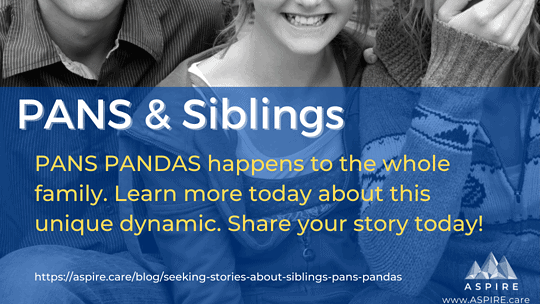
Finding the Right Fit at School for PANS PANDAS
I think the biggest thing you can do for your PANDAS kid is never to give up on them!! Find what works for them and always advocate for their health and education. When someone tells you they cant...

I think the biggest thing you can do for your PANDAS kid is never to give up on them!! Find what works for them and always advocate for their health and education. When someone tells you they cant...

Read about one family's journey of how they handled their daughter's inability to attend in-person school full time and ultimately weaving together a partial in-school and homebound instruction...

Anxiety is a major symptom of PANS and PANDAS. See more about the PANS PANDAS Diagnostic Criteria and Symptoms. Generalized Anxiety, particularly Separation Anxiety, a hallmark...

Share your PANS PANDAS story about how siblings are affected...

Chances are if you have PANS PANDAS, you have experienced issues with sleeping. Learn about reasons why this symptom is part of the Diagnostic Criteria. Come learn about why Sleep...

Sleep disturbances are common in children with PANS and are part of the diagnostic criteria. See more about the PANS PANDAS Diagnostic Criteria and Symptoms Some have trouble falling asleep...

A new onset of ADHD-like behaviors along with other PANS symptoms is one of the possible signs someone may have PANS...

You are being invited to participate in a research study affiliated with the Massachusetts General Hospital, called Investigating the Impact of the Coronavirus Pandemic on Children with...

This study evaluates the efficacy of naproxen sodium treat OCD symptoms in patients with suspected or diagnosed Pediatric Autoimmune Neuropsychiatric Disorder Associated with Streptococcal infections...

Groundbreaking, Emmy Nominated documentary on PANDAS by Tim Sorel, My My Kid Is Not Crazy: A Search for Hope in the Face of Misdiagnosis is now available for free on...

ASPIRE cosigned the Association for Accessible Medicines’ letter to the FDA urging them to prioritize patient access to more safe, effective, and affordable complex generic medicines in Generic...

The PANDAS Physicians Network (PPN) flowcharts for diagnosis and treatment will help clinicians evaluate their patients and determine the best course of treatment. Guidelines and workflows were...